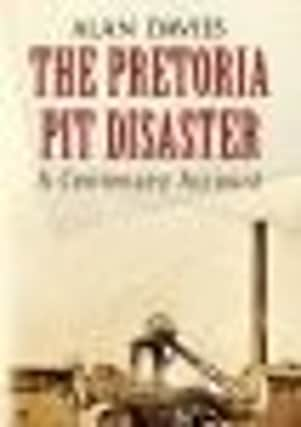Book review: The Pretoria Pit Disaster by Alan Davies


Shockwaves from the disaster echoed throughout the land ... after the initial horrors of the unimaginable loss of life, mines came under greater public scrutiny and greater efforts were made to improve safety.
But for the families involved, the repercussions and recriminations continued for many more years – not surprising as a total of 593 dependants including widows, children and parents were left needing urgent care.
Advertisement
Hide AdAdvertisement
Hide AdAnd the memories live on ... last year a new memorial to the victims was unveiled at Market Street, Westhoughton, a town which lost 145 men and boys.
Alan Davies, whose own collier grandfather was involved in the rescue operation at Pretoria Pit, sheds new light on the horrific events of Wednesday 21 December 1910 in his moving and definitive account of the third largest accident in British coal-mining history.
The colliery, sunk in 1900, had long been plagued with emissions of gas, particularly after roof falls, and on that fateful morning, tragically only a few days before Christmas, 889 men and boys travelled deep into the two 434-yard deep shafts, eager to put in extra effort in the run-up to the holiday season.
At 7.50am, there was an explosion of methane gas followed by a more powerful coal-dust blast, killing 342 pit workers and badly gassing many of the 545 survivors from other parts of the mine.
Advertisement
Hide AdAdvertisement
Hide AdOne of the first at the scene was the Belgian rector of Sacred Heart RC Church at Westhoughton, the Rev A.L.Coelenbier who saw hundreds of people running to the pithead, some with ‘their hands lifted heavenward’ and others ‘crying bitterly.’
He witnessed ‘appalling sights which no one will forget’ and ‘to hear the sobbing and sighing of the wives and children, brothers and sisters, was something beyond human endurance.’
Rescue teams from other local pits, including St Helens, Leigh and Atherton, performed heroically to bring up the bodies, some horribly mangled, and one elderly former collier was asphyxiated during a desperate bid to find his two sons.
One young woman, married for just a year, held her baby close and was only persuaded to leave the pit mouth after waiting a whole day and night for the husband she would never see again.
Advertisement
Hide AdAdvertisement
Hide AdThe stories of individual pain and suffering are as powerful today as they were 100 years ago ... a 10-year-old boy forced to identify the body of his father and a girl who lost her father, four brothers, two uncles and two cousins.
The Home Office Inquiry concluded that the explosion resulted from a gas ignition after a roof fall damaged a miner’s Wolf oil lamp, a make which had been causing safety concerns for some time previously.
As for compensation for the victims’ families, Davies says the records show that ‘life certainly came cheap in 1911’ – an average of £249 per man was awarded plus seven shillings a week for widows and two shillings a week for children.
Despite the introduction of the Coal Mines Act in 1911, many pits continued to be driven by profit motives at the expense of lives and 12 years after the Pretoria Pit disaster, a Welsh mineworker and trade unionist noted that nationally the colliery casualty list was still four men killed every 24 hours.
Advertisement
Hide AdAdvertisement
Hide AdDavies, who has worked at Parkside Colliery, Newton, Coventry Colliery, Bickershaw Colliery, Leigh and Castle Mine, Wigan, presents a wider picture of the disaster than has ever been attempted before.
His superbly detailed book brings together contemporary press accounts and many previously unpublished photographs as well as transcribed recordings from eye witnesses and one of the survivors.
Over the 34 years of its working life, Pretoria Pit witnessed the deaths of 368 of its miners ... a terrible toll for just one colliery.
(Amberley, paperback, £14.99)